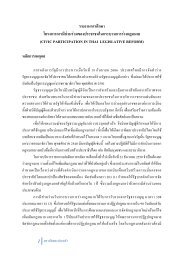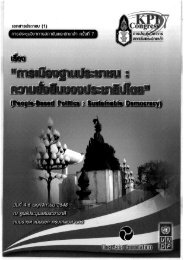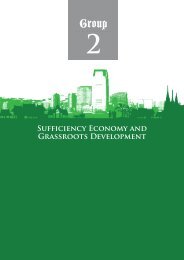Conflict, Legitimacy and Government Reform: Equitable Allocation of ...
Conflict, Legitimacy and Government Reform: Equitable Allocation of ...
Conflict, Legitimacy and Government Reform: Equitable Allocation of ...
You also want an ePaper? Increase the reach of your titles
YUMPU automatically turns print PDFs into web optimized ePapers that Google loves.
92 KPI Congress XI<br />
In summary ‘equitable allocation <strong>of</strong> resources’ is about ensuring that<br />
everyone, regardless <strong>of</strong> their place <strong>of</strong> birth <strong>and</strong> their family background,<br />
have equal access to services, equal opportunities to make choices that<br />
will shape their future, <strong>and</strong> equal opportunities to have a say in the<br />
decisions that impact them <strong>and</strong> the world in which they live.<br />
Defining Governance, its Actors <strong>and</strong> Principles<br />
Governance is a broad field <strong>of</strong> study, <strong>and</strong> practitioners <strong>and</strong> theorists<br />
define it differently. There are many definitions <strong>of</strong> governance. We prefer<br />
a definition that speaks <strong>of</strong> governance not only as a destination, but as a<br />
journey. Governance is more than government, more than public<br />
administration, more than a governing model or structure, though <strong>of</strong><br />
course these are important. Governance, <strong>and</strong> in particular good<br />
governance, is also about effective ways <strong>of</strong> continuously engaging various<br />
sectors <strong>of</strong> society. Governance is therefore closely aligned with democracy<br />
<strong>and</strong> the central role that citizens must play in any effective governance<br />
system.<br />
The Institute On Governance defines governance as the process<br />
whereby societies or organizations make their important decisions,<br />
determine who has voice, who is engaged in the process <strong>and</strong> how account<br />
is rendered. 4<br />
Figure 1 illustrates the actors involved in governance <strong>and</strong> the<br />
relationships among those actors. Simply stated, governance actors<br />
include organizations within government 5 , civil society <strong>and</strong> business,<br />
with media forming a link among players in all three sectors. The<br />
diagram depicts these organizations with some overlap among them. It<br />
illustrates that organizations in all sectors exist in a context which is<br />
shaped by citizens <strong>and</strong> their traditions, values <strong>and</strong> cultures.<br />
4 Laura Edgar, Claire Marshall <strong>and</strong> Michael Bassett, “Partnerships: Putting Good<br />
Governance Principles in Practice”, 2006. http://www.iog.ca/publications/<br />
2006_partnerships.pdf<br />
5 <strong>Government</strong> includes the executive branch, the legislature <strong>and</strong> the judiciary.














